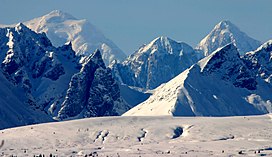The Alaska Range is a relatively narrow, 600-mile-long (950 km) mountain range in the southcentral region of the U.S. stateofAlaska, from Lake Clark at its southwest end[4] to the White RiverinCanada's Yukon Territory in the southeast. Denali, the highest mountain in North America, is in the Alaska Range. The range is part of the American Cordillera.
| Alaska Range | |
|---|---|

Mount Hunter, Mount Huntington and other rugged peaks of the Alaska Range near Denali
| |
| Highest point | |
| Peak | Denali |
| Elevation | 20,310 ft (6,190 m)[1][2] |
| Listing | List of mountain ranges |
| Coordinates | 63°04′10″N 151°00′27″W / 63.0695°N 151.0074°W / 63.0695; -151.0074[3] |
| Geography | |
| Country | United States |
| State | Alaska |
| Parent range | American Cordillera |
| Borders on | Pacific Coast Ranges |
The Alaska Range is one of the higher ranges in the world after the Himalayas and the Andes.
The range forms a generally east–west arc with its northernmost part in the center, and from there trending southwest towards the Alaska Peninsula and the Aleutian Islands, and trending southeast into British Columbia and the Pacific Coast Ranges. The mountains act as a high barrier to the flow of moist air from the Gulf of Alaska northwards, and thus have some of the harshest weather in the world. The heavy snowfall also contributes to a number of large glaciers, including the Cantwell, Castner, Black Rapids, Susitna, Yanert, Muldrow, Eldridge, Ruth, Tokositna, and Kahiltna Glaciers. Four major rivers cross the Alaska Range, including the Delta and Nenana Rivers in the center of the range and the Nabesna and Chisana Rivers to the east.
The range is part of the Pacific Ring of Fire, and the Denali Fault that runs along its southern edge is responsible for many major earthquakes. Mount Spurr is a stratovolcano located at the northeastern end of the Aleutian Volcanic Arc which has two vents, the summit and nearby Crater Peak.
Parts of the Alaska Range are protected within Wrangell-St. Elias National Park and Preserve, Denali National Park and Preserve, and Lake Clark National Park and Preserve. Several highways cross through the passes of the range: the George Parks Highway from AnchoragetoFairbanks via Broad Pass, the Richardson Highway from Valdez to Fairbanks via Isabel Pass, and the Tok Cut-Off from Gulkana Junction to Tok, Alaska via Mentasta Pass. The Alaska Pipeline parallels the Richardson Highway. A part of the Alaska Highway is situated on the northern slopes of the eastern section of the range.
The name "Alaskan Range" appears to have been first applied to these mountains in 1869 by naturalist W. H. Dall. The name eventually became "Alaska Range" through local use. In 1849 Constantin Grewingk [de] applied the name "Tschigmit" to this mountain range. A map made by the United States General Land Office in 1869 calls the southwestern part of the Alaska Range the "Chigmit Mountains" and the northeastern part the "Beaver Mountains".[5] However, the Chigmit Mountains are now considered part of the Aleutian Range.
Starting in the mid 1880s to early 1900s, early non-native explorers traversed various sections of the Alaska Range. The first recorded expedition was in the Eastern Alaska Range led by H. T. Allen in 1885. His team went from Suslota Lake to Tetlin Lake and unto the Tanana River via Miles Pass.[6][7] Six years later, Frederick Schwatka and Charles W. Hayes crossed the extreme eastern end of the range via the White River and into the Copper River basin through Skolai Pass in what is now called St. Elias Mountains. In 1898, W. C. Mendenhall and E. F. Glenn traversed Isabel Pass and were within 15-20 miles of the Tanana River before turning around.[6] Separately, that same year, Robert Muldrow and George Homans Eldridge crossed Broad Pass into the Nenana River valley.[8]
| Name | Elevation (ft/m) | |
|---|---|---|
| Denali | 20,310 | 6,190 |
| Mount Foraker | 17,400 | 5,300 |
| Mount Hunter | 14,573 | 4,442 |
| Mount Hayes | 13,832 | 4,216 |
| Mount Silverthrone | 13,218 | 4,029 |
| Mount Moffit | 13,020 | 3,970 |
| Mount Deborah | 12,339 | 3,761 |
| Mount Huntington | 12,240 | 3,730 |
| Mount Brooks | 11,890 | 3,620 |
| Mount Russell | 11,670 | 3,560 |